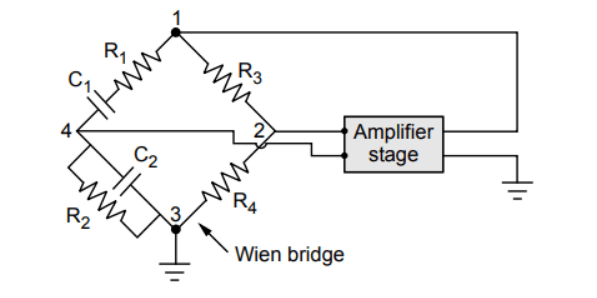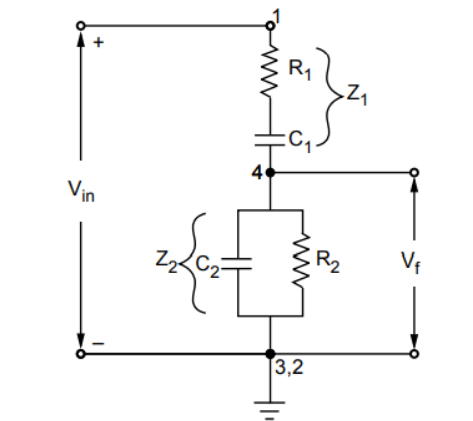Wien Bridge Oscillator
The Wien bridge oscillator is an RC oscillator that uses a Wien bridge circuit as its feedback network.
- The amplifier used in this oscillator is a non-inverting amplifier, which does not introduce any phase shift.
- The feedback network, a Wien bridge circuit, also does not introduce any phase shift.
- Therefore, the phase shift around a loop in a Wien bridge oscillator is .
The figure below shows the basic circuit of the Wien bridge oscillator.

In this setup:
- The output of the amplifier is applied between terminals 1 and 3, while the amplifier is powered from terminals 2 and 4, which is the output of the feedback network.
Derivation of Frequency
The figure below illustrates the feedback network of the Wien bridge oscillator.

-
The two arms of the feedback network are , (in series) and , (in parallel). These arms are frequency-sensitive and are therefore the focus of this analysis.
-
The input to the feedback network is , applied between terminals 1 and 3, which is the amplifier output.
-
The output of the feedback network is , taken from terminals 2 and 4.
-
This network is also known as a lead-lag network.
-
The voltage across is due to the current .
Using the expressions for and and simplifying:
Rationalizing and simplifying:
-
To achieve zero phase shift, the imaginary part of the above equation must be zero:
but cannot be zero,
-
In practice, if and , then:
Using in equation (i), we get the magnitude of the feedback network as:
-
For sustained oscillations, , hence for the Wien bridge oscillator.
-
Thus, the gain of the amplifier stage must be at least 3 to ensure sustained oscillations.
-
If and , then using in equation (i), we get:
and
Advantages of the Wien Bridge Oscillator
- By mounting the two capacitors on a common shaft and varying their values, the frequency can be adjusted as needed.
- Due to the use of a two-stage amplifier, the gain is high.
- The stability is high.
- It provides stable, low-distortion sinusoidal output.
- The frequency range can be easily selected using decade resistance boxes.
- The circuit is straightforward to design and provides a constant output.
Disadvantages of the Wien Bridge Oscillator
- It cannot generate very high frequencies.
- The circuit requires two transistors and a considerable number of other components.
- The maximum frequency is limited by the amplitude and phase shift characteristics of the amplifiers.